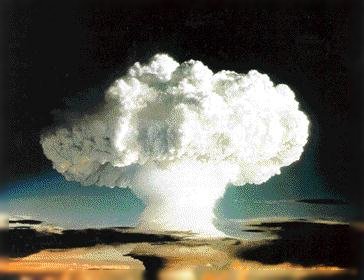I'm sure these guys will have absolutely no problem with this:
The budget is busted; American soldiers need more armor; they're running out of supplies. Yet the Department of Energy is spending an astonishing $6.5 billion on nuclear weapons this year, and President Bush is requesting $6.8 billion more for next year and a total of $30 billion over the following four years. This does not include his much-cherished missile-defense program, by the way. This is simply for the maintenance, modernization, development, and production of nuclear bombs and warheads.
Measured in "real dollars" (that is, adjusting for inflation), this year's spending on nuclear activities is equal to what Ronald Reagan spent at the height of the U.S.-Soviet standoff. It exceeds by over 50 percent the average annual sum ($4.2 billion) that the United States spent—again, in real dollars—throughout the four and a half decades of the Cold War.
There is no nuclear arms race going on now. The world no longer offers many suitable nuclear targets. President Bush is trying to persuade other nations—especially "rogue regimes"—to forgo their nuclear ambitions. Yet he is shoveling money to U.S. nuclear weapons laboratories as if the Soviet Union still existed and the Cold War still raged.
~snip~
The one aspect of this reorientation that's attracted some attention is the development of a "robust nuclear earth-penetrator" (RNEP)—a warhead that can burrow deep into the earth before exploding, in order to destroy underground bunkers. The U.S. Air Force currently has some non-nuclear earth-penetrators, but they can't burrow deeply enough or explode powerfully enough to destroy some known bunkers. There's a legitimate debate over whether we would need to destroy such bunkers or whether it would be good enough to disable them—a feat that the conventional bunker-busters could accomplish. There's a broader question still over whether an American president really would, or should, be the first to fire nuclear weapons in wartime, no matter how tempting the tactical advantage.
The point here, however, is that this new nuclear weapon is fast becoming a reality.
As chronicled in a recent report by the Congressional Research Service, when Bush started the RNEP program two years ago, it was labeled as strictly a research project. Its budget was a mere $6.1 million in Fiscal Year 2003 and $7.1 million for FY 04. Now, all of a sudden, the administration has posted a five-year plan for the program amounting, from FY 2005-09, to $485 million. The FY05 budget alone earmarks $27.5 million to begin "development ground tests" on "candidate weapon designs." This isn't research; it's a real weapon in the works.
Go read the whole thing. It will fill you with pride, and dread.
Thanks to Slyblog for the heads up.
I guess now is the time I should be buying one of these.

Measured in "real dollars" (that is, adjusting for inflation), this year's spending on nuclear activities is equal to what Ronald Reagan spent at the height of the U.S.-Soviet standoff. It exceeds by over 50 percent the average annual sum ($4.2 billion) that the United States spent—again, in real dollars—throughout the four and a half decades of the Cold War.
There is no nuclear arms race going on now. The world no longer offers many suitable nuclear targets. President Bush is trying to persuade other nations—especially "rogue regimes"—to forgo their nuclear ambitions. Yet he is shoveling money to U.S. nuclear weapons laboratories as if the Soviet Union still existed and the Cold War still raged.
~snip~
The one aspect of this reorientation that's attracted some attention is the development of a "robust nuclear earth-penetrator" (RNEP)—a warhead that can burrow deep into the earth before exploding, in order to destroy underground bunkers. The U.S. Air Force currently has some non-nuclear earth-penetrators, but they can't burrow deeply enough or explode powerfully enough to destroy some known bunkers. There's a legitimate debate over whether we would need to destroy such bunkers or whether it would be good enough to disable them—a feat that the conventional bunker-busters could accomplish. There's a broader question still over whether an American president really would, or should, be the first to fire nuclear weapons in wartime, no matter how tempting the tactical advantage.
The point here, however, is that this new nuclear weapon is fast becoming a reality.
As chronicled in a recent report by the Congressional Research Service, when Bush started the RNEP program two years ago, it was labeled as strictly a research project. Its budget was a mere $6.1 million in Fiscal Year 2003 and $7.1 million for FY 04. Now, all of a sudden, the administration has posted a five-year plan for the program amounting, from FY 2005-09, to $485 million. The FY05 budget alone earmarks $27.5 million to begin "development ground tests" on "candidate weapon designs." This isn't research; it's a real weapon in the works.













<<<<< Home